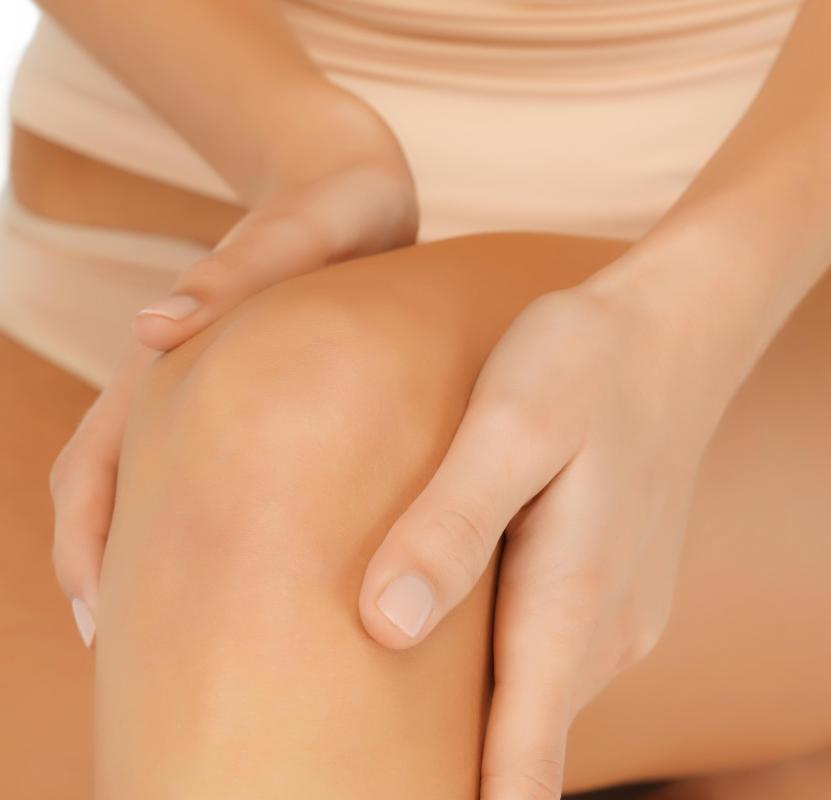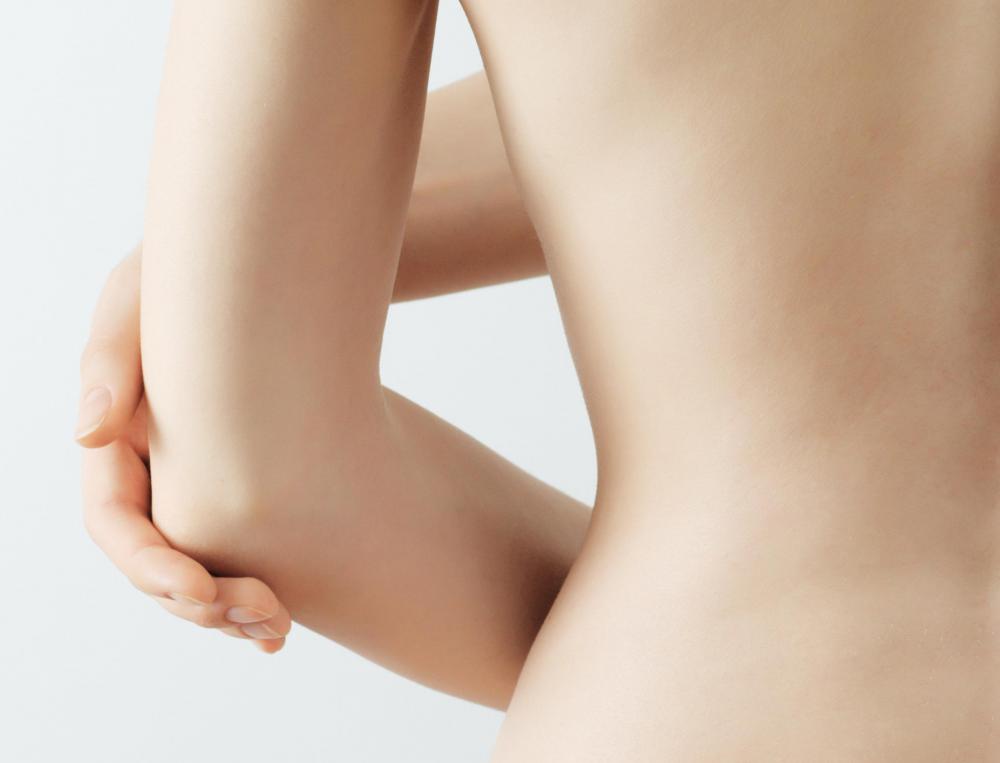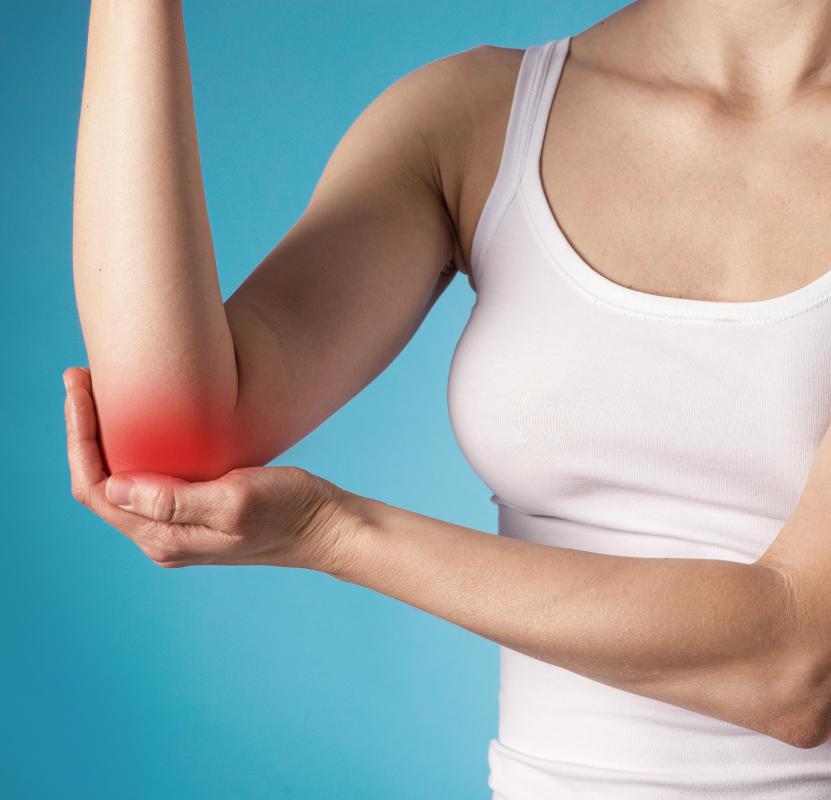At TheHealthBoard, we're committed to delivering accurate, trustworthy information. Our expert-authored content is rigorously fact-checked and sourced from credible authorities. Discover how we uphold the highest standards in providing you with reliable knowledge.
What Is a Bursa Sac?
A bursa sac is a small, fluid-filled pouch located in various parts of the body, especially in or near joints, that acts as a cushion between moving parts of the body. The bursa sac is filled with fluid to allow flexing of the membrane, while the tougher outer layer keeps the sac intact during movement. A bursa sac can become inflamed and cause a condition known as bursitis, and this condition can occur in several joints throughout the body. The most common instances of bursitis occur in the knees and hips, though other areas of the body are susceptible as well.
Synovial fluid fills the bursa sac. This fluid is about the consistency of many cooking oils, and it allows the bursa sac to move appropriately within the joint. When the joint begins to move in ways it is not designed to, the bursa can become inflamed, leading to bursitis that causes pain, stiffness, or other discomfort in the joint. Rest is usually enough to allow the bursa to heal, though in some instances, a doctor may prescribe anti-inflammatory medications. In very serious cases, a doctor may choose to cut the bursa to alleviate pressure. The bursa will grow back after time.

When a bursa sac is functioning correctly, it will not be felt at all. If it is not functioning correctly, the area of the body in which the bursa sac is situated may swell, depending on the intensity of the inflammation. Inflammation of the bursa can occur without any external indicators such as swelling, and the pain can be just as significant. If pain is felt in a joint, it is advisable to consult a doctor to find the cause of the pain; bursitis may be the cause, but countless other conditions can cause similar pains in the joints of the body.

The location of a bursa sac can vary depending on the joint. Some bursae are located around the area where two bones come together in a joint, while others are situated between tendons, ligaments, or muscles. Bursae are often located both above and below the knee cap, as well as on the inside or outside of the knee, and these bursae are some of the most commonly inflamed in the body. Bursae are also present in the elbow, and people who do heavy lifting regularly or participate in sports that require the use of the arms are more likely to experience bursitis in the elbow.
What Causes a Bursa Sac?

Bursa sacs are naturally occurring formations in the human body, most of which are present at birth, while some others may form over time due to friction. These sacs are fluid-filled pouches, most often located around joints, providing cushioning for the body's movements. They are not noticeable unless symptoms of inflammation, also known as bursitis, develop. Here are the problems to look for:
- The first indication of bursitis may be joint achiness and stiffness.
- The joint soreness is more noticeable with pressure or movement.
- The area could appear red and swollen.
- The achiness may turn into pain which can worsen over time.
Why Bursitis Develops

Repetitive motion is the most common cause of bursitis, such as bursitis in the shoulder from long hours of playing baseball. Constant pressure is also a cause, as can happen in the knees from gardening or cleaning floors. Injury, arthritis and gout can also be reasons for this type of inflammation.
Does a Ruptured Bursa Sac Heal Itself?
A bursa sac that is merely inflamed will often be able to heal on its own, depending on the level of inflammation and if the individual can rest the afflicted area. If the joint is not rested or the bursa sac has actually ruptured, meaning the tissue has torn, then intervention may be necessary. This is particularly true if an infection is affecting the surrounding tissue.
Treating Sore Areas

When pain and swelling around a joint first appears, you can apply ice right away and over the next 48 hours. You can rest the area and take an over-the-counter pain reliever or anti-inflammatory medication. If these measures do not provide you any relief or if any of the following symptoms are present, it's best to contact a physician to avoid further injury.
- The joint is unable to be moved.
- The joint pain is disabling.
- There is extreme swelling, redness or a rash present.
- The pain is sharp or shooting in nature.
- Fever or chills are present.
What Happens If a Bursa Sac Ruptures?

If there is direct injury to the bursa sac or inflammation is left without treatment, the sac can rupture. This means that the bursa sac tears and fluid can leak into the surrounding tissue, which is a more serious situation. If resting and icing the area has provided you no relief, or if any of the above warning signs are present, a doctor may recommend the following interventions.
Diagnostic Tests

The first thing the doctor may do after a preliminary examination is to perform an X-ray and/or MRI of the affected area. This will allow the physician to better understand what is going on and recommend the best treatment for your injury. Blood tests may also be ordered depending on what the initial intake and exam reveal.
Medications
A doctor may give you anti-inflammatory medication as well as a pain reliever so that the patient can begin to get some relief. If there is an infection present, an antibiotic may also be recommended. In addition, it's possible that a corticosteroid will be injected into the joint. One shot can sometimes be sufficient for resolving the inflammation.
Physical Therapy
Depending on the cause of the ruptured bursa sac, your doctor may refer you to a physical therapist. Focused exercise can help to strengthen the affected area, making it less likely for the rupture to reoccur.
Surgery
In some more extreme cases, a surgical draining technique may be used on an inflamed bursa to remove excess fluid. Alternatively, the bursa may need to be removed surgically, though this is quite rare.
What Are the Most Common Bursa Sac Injuries?
Along with asking, "Where are bursa sacs located in the body?", it is important to know which bursae are most frequently injured. Although there are bursa sacs located throughout the body functioning as padding for a variety of joints, there are areas more at risk than others.
In calculating how long does a bursa sac take to heal, a deciding factor will be the location of the bursa, the frequency of use of the underlying joint and the individual's ability to isolate and rest that joint to give it time to heal. This makes the bursa injuries listed here uniquely challenging as they occur in not only the most frequently used joints but in those that are particularly difficult to isolate.
Shoulder Bursitis
This form of bursitis occurs in the large shoulder joint. The bursa runs over the top of the shoulder underneath the AC tendon and over the supraspinatus tendon. Bursitis in this region is commonly due to repetitive overhead motion. It can also be caused by carrying excess weight on the surface of the shoulder. College students frequently experience pain caused by bursa inflammation due to the weight of a backpack on this area of the shoulder.
Knee Bursitis
There are two main types of bursitis in the knee area. The first is pes anserine bursitis which occurs on the inside of the knee, under the shin. There are many causes, including insufficient stretching before exercise, obesity and arthritis. The second common type of knee bursitis is prepatellar bursitis which is usually caused by the pressure of kneeling for long periods.
Hip Bursitis
There are two sets of bursae in the hip area, one on the outside and one on the inside near the groin. Inflammation of the outer hip bursa is much more common and is frequently experienced by athletes such as runners. Issues with the inner hip bursa are often mistaken for a muscular groin pull because the pain is in the groin rather than the large hip joint.
Elbow Bursitis
This occurs with inflammation of the bursa located between the skin of the elbow and the joint. It can be caused by repetitive movement, but it is also caused by putting too much pressure on the joint by leaning on the elbows consistently and for long periods of time.
For those wondering, "Does a ruptured bursa sac heal itself in these key areas?" the answer is, "Possibly". Due to the challenge of resting joints responsible for functional movement, it can be difficult for ruptured bursae in these areas to heal without intervention.
What Are Some Complementary Therapies for Bursitis?
While rest and joint immobilization are essential for healing the bursae, there are complementary therapies for those seeking a holistic solution.
- Anti-inflammatory supplements such as omega-3 fatty acids, bromelain and vitamin C
- Anti-inflammatory herbs such as curcumin and white willow
- Gentle movement to increase flexibility and strength, including yoga, tai chi and pilates
- Acupuncture to help with pain and inflammation
AS FEATURED ON:
AS FEATURED ON:

















Discuss this Article
Post your comments